
“I don’t have enough fingers to count what was th 2024-10-28 09:7:40 Author: www.bellingcat.com(查看原文) 阅读量:35 收藏
“I don’t have enough fingers to count what was there,” says Nelia Stryzhakova as she recalls the Ukrainian town of Vovchansk, where she has lived for the past 40 years.
“There was a technical school, a medical school, seven schools, many kindergartens. How many factories did we have? An oil extraction factory, a butter factory, a furniture factory, a carriage factory, of which there were only two in Ukraine.”
The director of the local library, Stryzhakova, was among those to flee Vovchansk when Russian forces began to advance on the city in May this year.
Vovchansk is an administrative centre in the north-east of Ukraine, divided by the Vovcha river, and just five kilometres from the Russian border. In 2022, Vovchansk had 17,000 inhabitants, many with relatives in Russia.
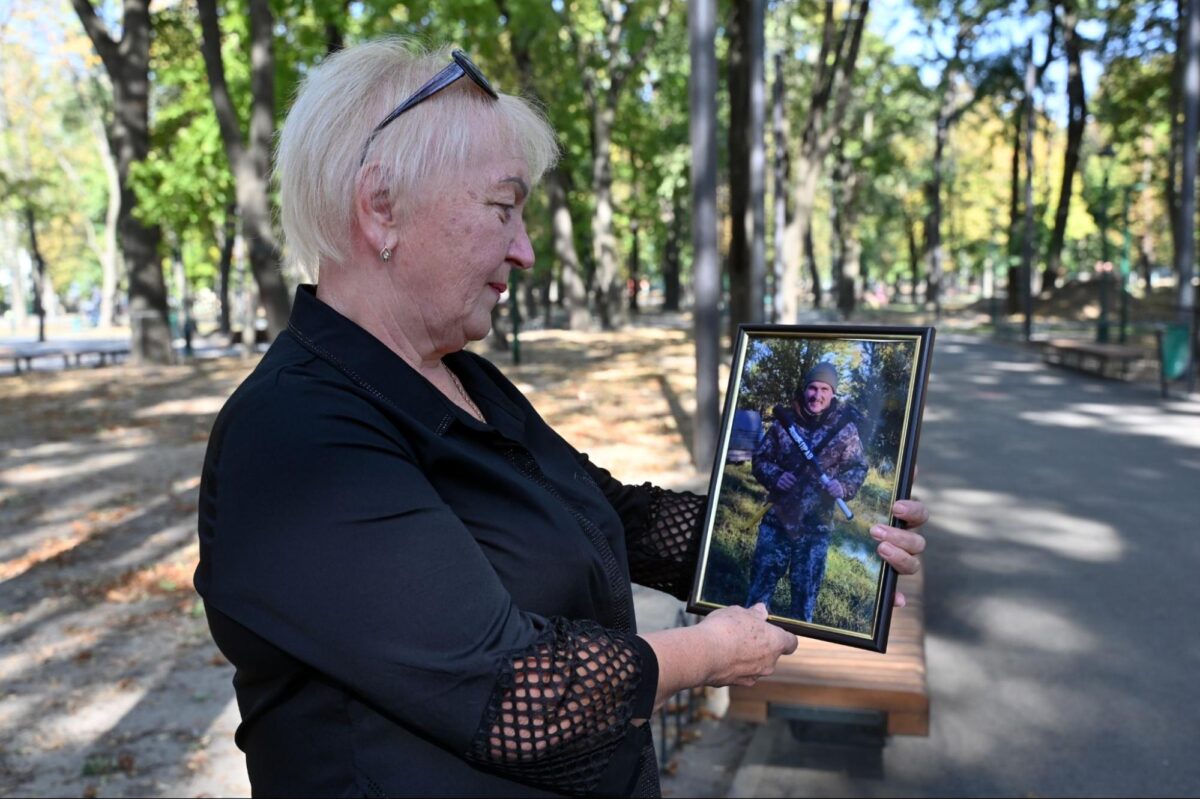
“The city is beautiful, the people are beautiful, we had everything. We didn’t even think that in (just) five days we would be blown off the ground like that,” Stryzhakova said.
Her words are backed up by video and social media evidence that show explosion after explosion across the city.
Bellingcat and journalists from Agence France-Presse (AFP) bureaus in Kyiv, Kharkiv and Paris have partnered to investigate the damage in the city and talk to former residents who have first-hand experience of the destruction.
An analysis of satellite imagery suggests that 60 percent of buildings in Vovchansk have been completely destroyed.
Partial damage was observed on a further 18 percent of buildings, leaving just 22 percent of the city where damage has yet to be detected as of late September 2024.
Kindergartens, schools, religious sites, factories and libraries have all been wiped out. Videos and drone footage show a desolate landscape where only the burnt-out skeletons of buildings once stood. Residents now living as refugees in nearby Kharkiv, like Stryzhakova, describe desperately fleeing the town under heavy bombardment.
“I took my documents from work and a couple of personal items,” Stryzhakova said. “That’s all I have. Objects are not the most important,”
The north of Vovchansk, where the majority of fighting has taken place, has been almost entirely destroyed or seriously damaged. The city centre also appears to be so severely affected that few structures remain. According to the city’s mayor, ninety percent of the centre has been “flattened”.
Although areas south of the Vovcha river that flows through Vovchansk have been badly impacted, especially in industrial districts and houses along major roads, large pockets of intact housing are still visible.
Bellingcat used SkySat imagery from Planet Labs PBC to carry out a damage assessment on a building-by-building basis. The process manually mapped out damage observed in the satellite imagery into three categories in the map below – green, orange, and red. Green corresponds with no observed damage, orange categorises indications of damage, and red means the destruction of a building (readers can zoom in and switch between satellite imagery dates as well as show or hide the damage assessment layer).
The destruction in Vovchansk soared after Russia’s most recent offensive began in May.
More on our Map Methodology
The process of manually mapping out damage in Vovchansk sorted the buildings observed in the satellite imagery into three categories – green, orange, and red.
Green corresponds with no observed damage. This means that at the resolution and angle of satellite imagery used, no damage was observed to the structure, this leaves the possibility of damage which was not visible in the imagery.
Orange categorises indications of damage, which are assessed by a broad range of features. This could be indications of superficial damage to the roof of buildings, even extending to the apparent removal of the roof, but in which the ceiling appears to be intact, preventing the satellite from seeing inside the walls of the structure. Other indications of damage could be visible debris surrounding the building, particularly when combined with visible artillery impact craters.
Red means the destruction of a building. This could be when a building has been completely reduced to rubble, or when the roof has been shelled so intensely that the inside of the building’s walls is visible. A caveat to this rule is multi-storey apartment buildings, where signs of extreme fire damage or partial collapses of the building’s facade will also fall under the red category.
Decisions on these classifications are based on visual evidence on the map and we cannot completely rule out the possibility of damage having occurred that is not visible on the map.
Other towns and cities on the front line in Ukraine have faced a similar fate.
Bakhmut in eastern Ukraine’s Donetsk Oblast was once home to 70,000 people before it was almost completely destroyed during intense fighting in 2023.
Lieutenant Denys Yaroslavsky of Ukraine’s 57th Brigade Reconnaissance Unit fought in both Bakhmut and Vovchansk. “The pace of destruction was so fast. What happened in Bakhmut in two or three months happened in Vovchansk in two or three weeks. Perhaps it was due to the proximity of the border, or the increase in the number of guided aerial bombs and the intensification of heavy fire,” he said.
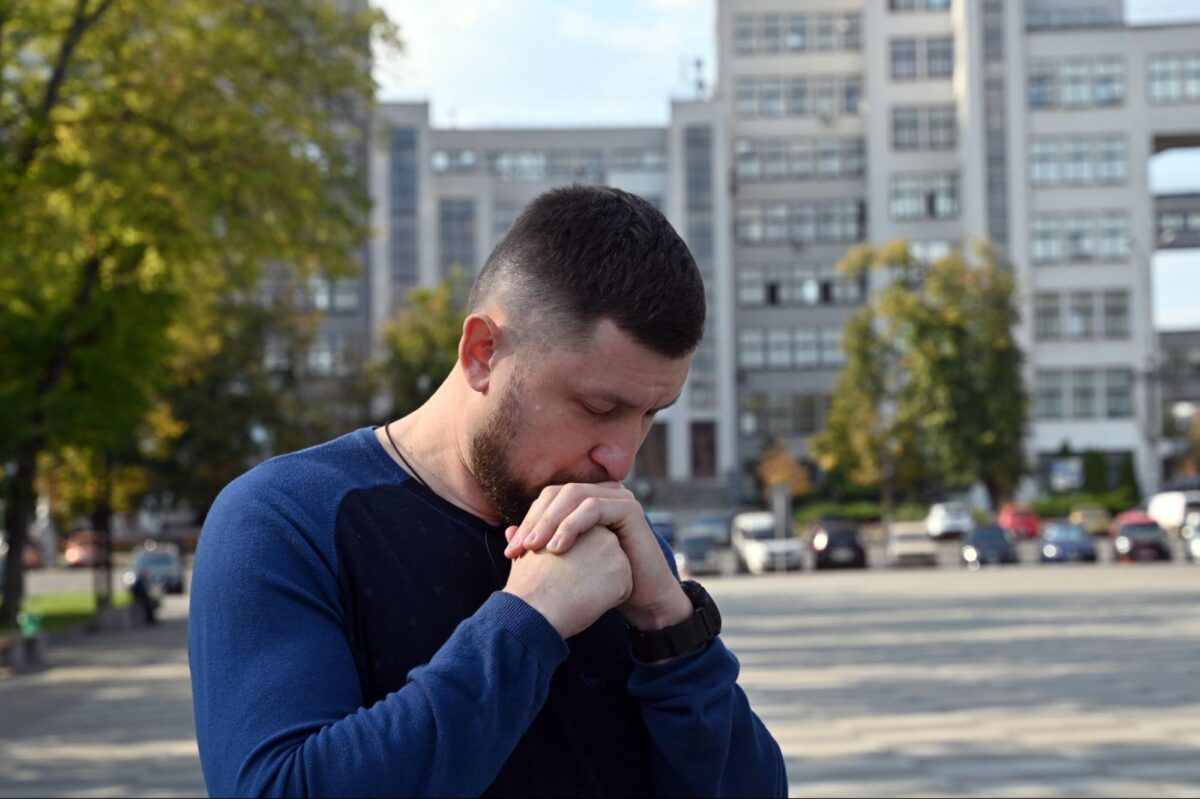
In Vovchansk, control of the town has switched between Ukrainian and Russian forces and back again. After Russian troops rolled in at the start of the country’s full invasion in February 2022, Ukraine forced a retreat with an autumn counter-offensive. In May this year, however, Russia again pushed forward towards Vovchansk. The intensity of the attack forced residents to flee.
Ukraine hit back over the summer months, with the fierce fighting leading to further destruction.
Videos posted to social media channels have documented the weapons, tactics and targeting that have led to the city’s near obliteration. One video from late May filmed from a DJI drone showed Russian glide bombs – air-launched, often Soviet-era weapons ordnance fitted with wings and satellite-aided navigation to extend their range and precision – landing a direct hit on a multi-storey residential building. The video was watermarked with an emblem for Akhmat’s “Barbarian” Unmanned Aerial Vehicle (UAV) detachment, which has posted many such videos.
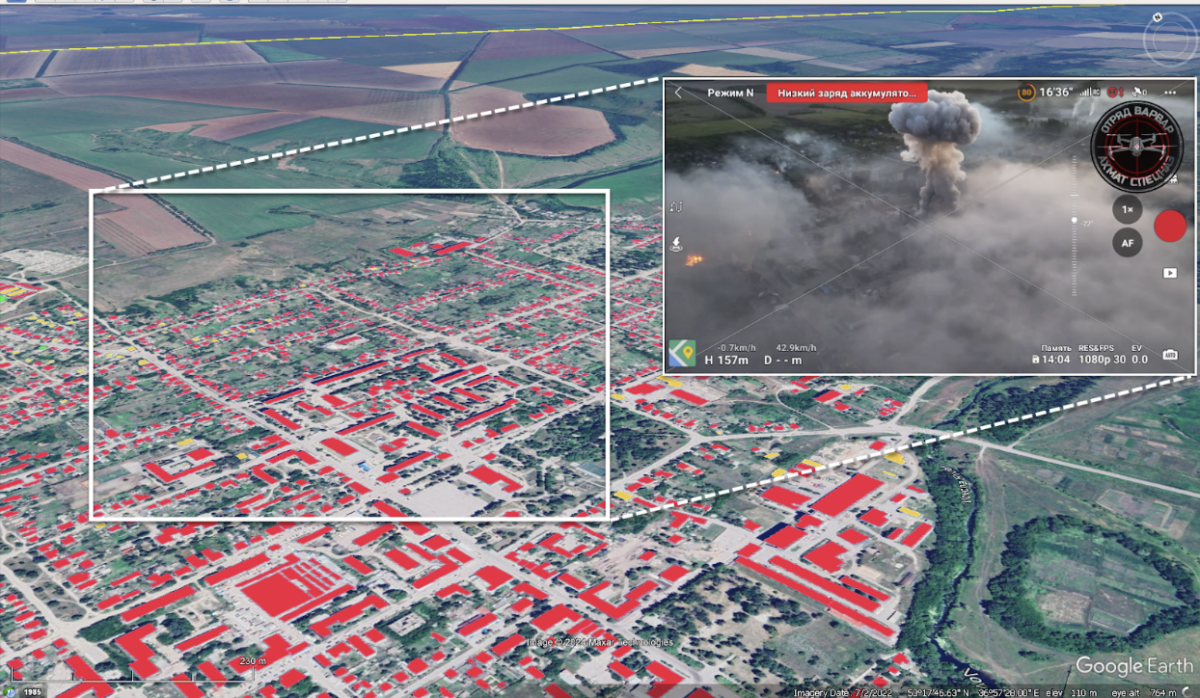
In the south of the city, a July 9 video posted to Telegram by Russian news outlet, Izvestiya, showed simultaneous impacts of several Russian FAB-500 glide bombs near one of the main roads leading into the city centre from the south.
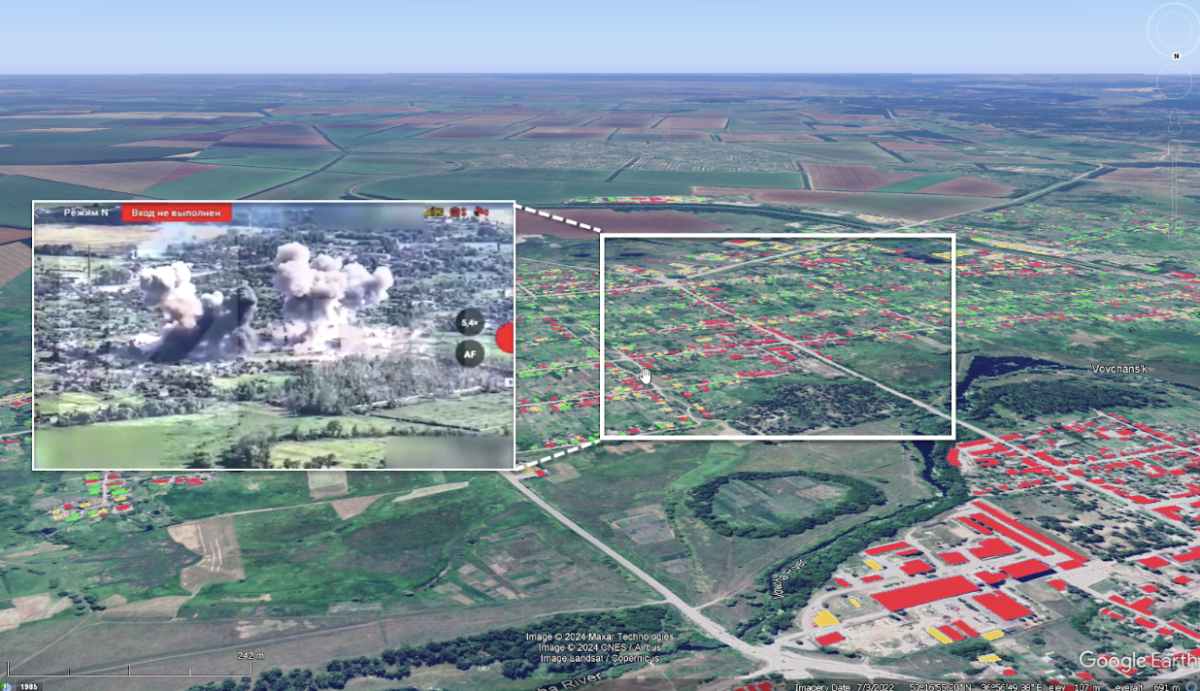
While fighting has subsided since the summer months, the city remains far from safe.
Recent reports suggested Russian forces dropped an ODAB-9000 thermobaric bomb, a powerful weapon designed to create a huge blast wave over a wide area, in the centre of the town in late September. However, Ukrainian authorities disputed this claim, suggesting that such reports were part of an information war and that a smaller and less powerful munition had been used.
‘No one could get us out of there’
Yaroslavsky described finding a once peaceful city turned into a desolate wasteland.
“Currently, Vovchansk is completely destroyed. Yes, it is under control. Yes, we have taken out the enemy and are trying to take physical control of these ruins. But the city does not exist. Seventeen-thousand people lost their homes, and why? Because someone did not build fortifications,” he said, blaming “negligence or corruption”.
Journalists from AFP bureaus in Kyiv, Kharkiv and Paris met and spoke with Yaroslavsky as well as a group of former Vovchansk residents during a recent trip to Kharkiv. Many have remained there as refugees since the beginning of the summer when the most intense fighting began.
They provide a human face to the destruction that can be seen on satellite imagery and in battle videos. Several even described the terror of being faced with a seemingly never-ending barrage of artillery and of seeing their neighbours perish.
Galyna Zharova, a 50-year-old native of Vovchansk, described living at 16 A Stepova Street in the north of the city until May 10 this year. Damage analysis shows the home she and her family lived in completely wiped from the map. Recent satellite imagery further confirmed this.
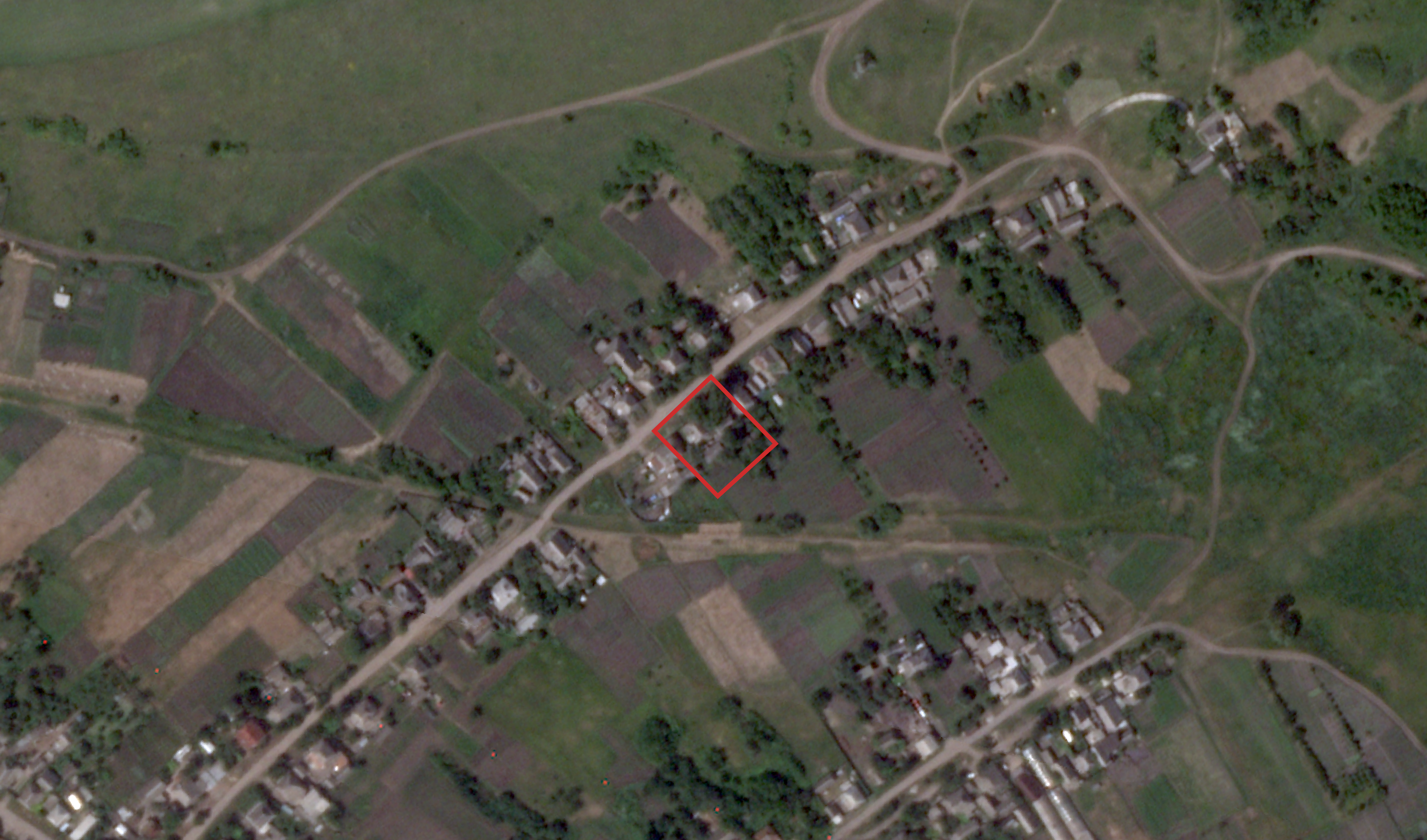
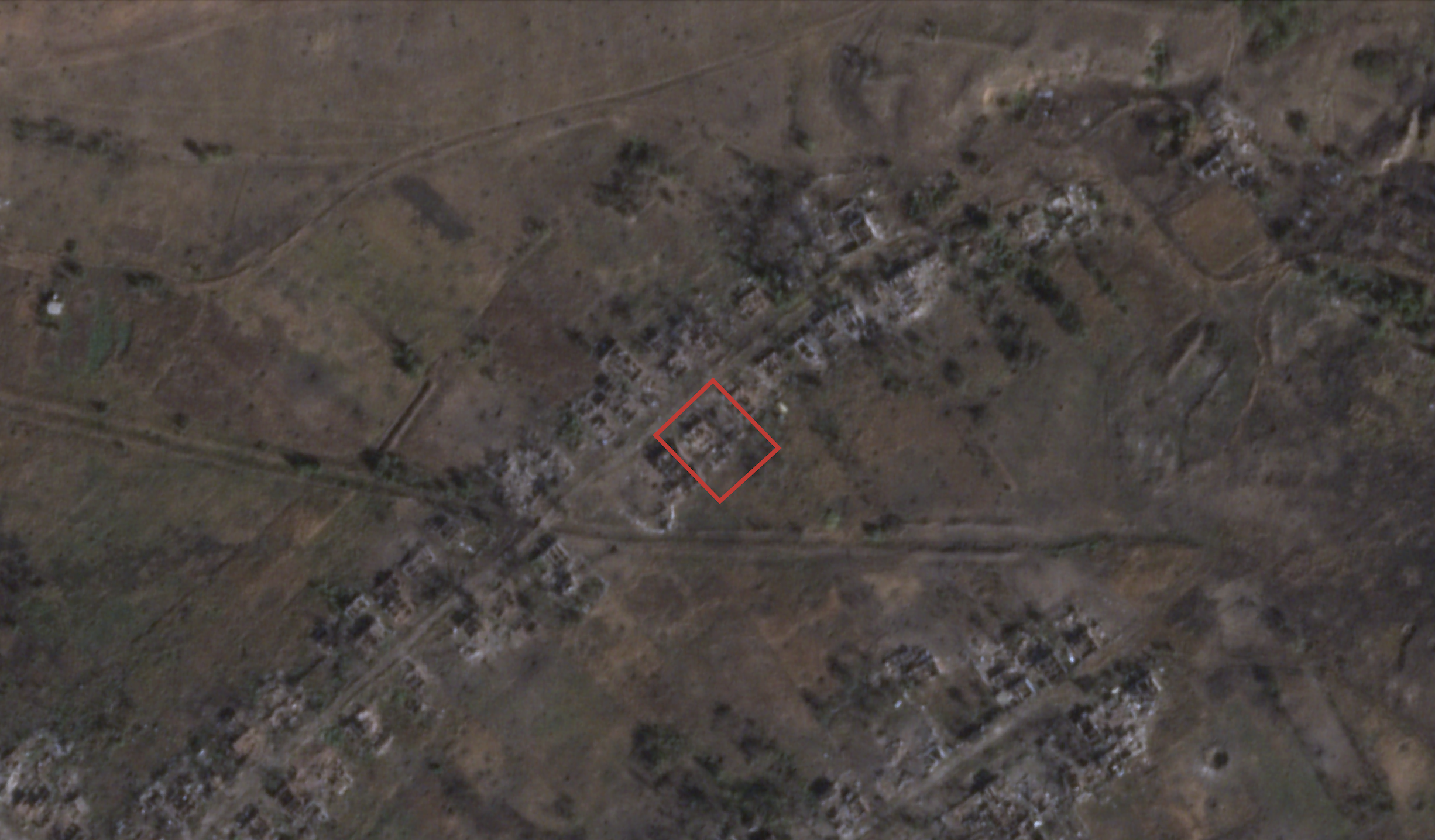
Now living in a former residence for foreign students in Kharkiv, she recalled a dramatic tale of escape.
“We were right on the front line, you understand? No one could get us out of there,” Zharova said.
“All the buildings burned down and we were crammed into cellars,” her husband, Victor, 65, continued.
The couple finally decided to flee on foot on June 3. “The drones were flying (around us) like wasps, like mosquitoes,” Galyna Zharova remembers.
They said they walked for several kilometres before they were picked up by Ukrainian volunteers and taken to safety.
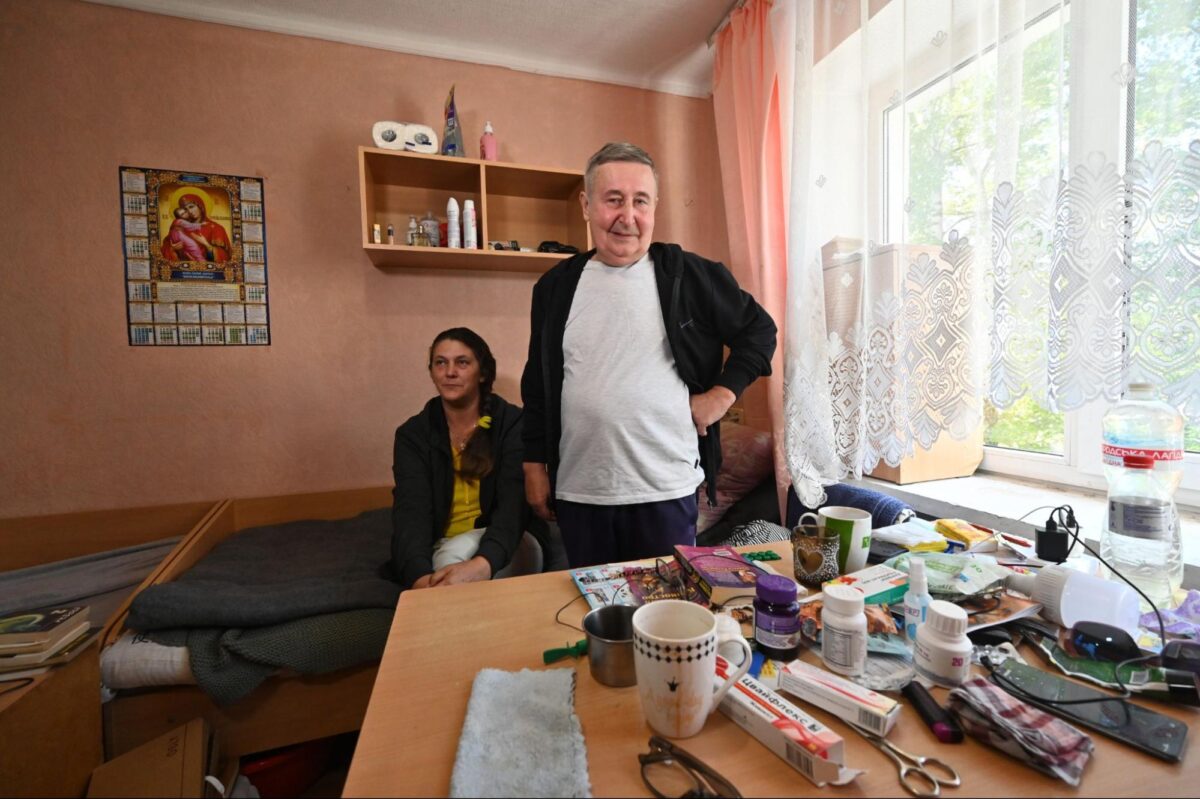
‘It’s All Over’
While many now refugees from Vovchansk describe losing their homes, others talk of the community and loved ones who didn’t make it.
The aforementioned Nelia Stryzhakova, ran the municipal library for the past five years at 8 Torhova Street. It went up in smoke, along with its 125,000 books after Russia attacked.
Comparison imagery shows little else was left standing in this once busy part of town.
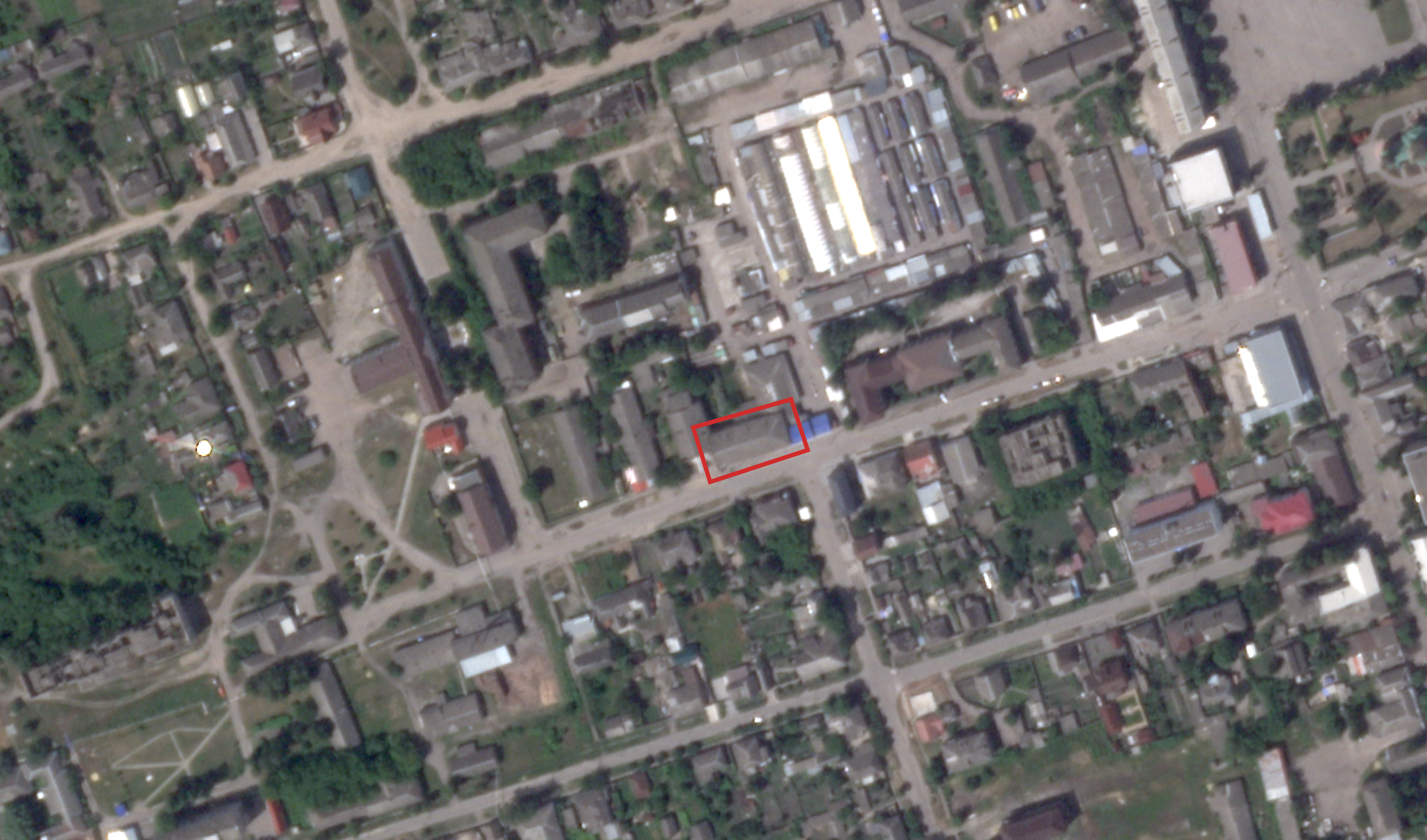
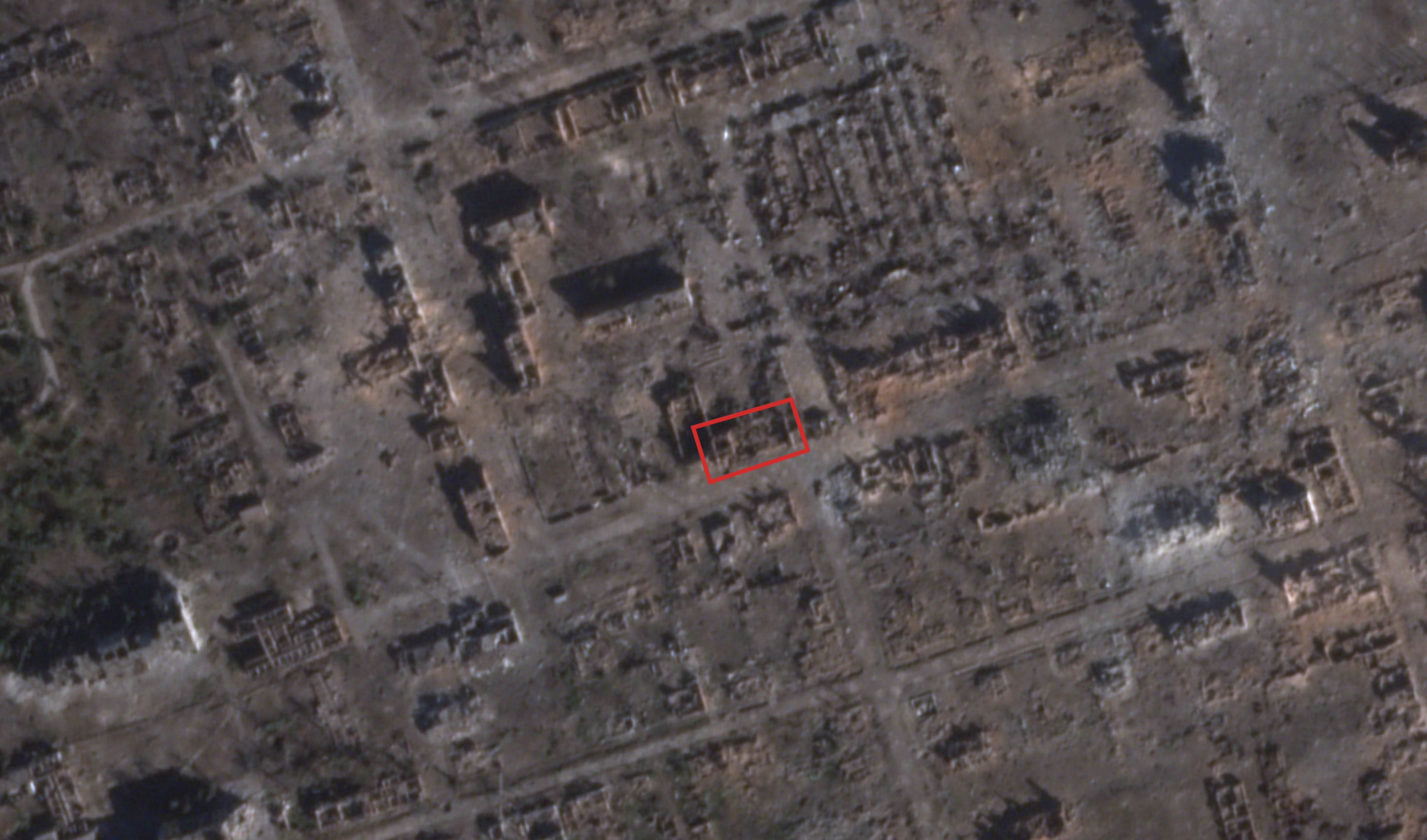
Even more painful for Stryzhakova, her only son was killed fighting for Ukraine in the battle for Bakhmut.
“I no longer read Russian classics. I understand that you can’t blame literature, but I am disgusted with Russia, their laws, everything. They took my child away. I’m sorry, but it’s personal,” the former library director said.
Kira Dzhafarova, who runs a private clinic in Kharkiv, is another to experience the suffering of human loss. She assumes that her mother, Valentina Radionova, 85, died after refusing to leave her house in the centre of the city. Their last telephone conversation was on May 17.
She saw her mother’s house razed to the ground in drone footage. “Since then, I’ve realised that it’s all over,” she says. She has given her DNA for possible identification, if and when the end of the fighting makes it possible to approach the rubble.
Dzhafarova describes how most of the residents of Vovhchansk were Russian speakers and had relatives in Russia, given the city’s proximity to the border. Some even worked across the border before the war, she said.
Stryzhakova has the same experience. “There are mixed families. Parents, children – we are all connected. And now we have become enemies. There’s no other way to describe it.”
The familiarity and trust, Dzhafarova believes, helped convince her mother to stay. Propaganda may also have played a part.
“She believed that Kharkiv would be worse than Vovchansk because she watched Russian television,” Dzhafarova said.
“Terrible, Terrible Shelling”
Tamaz Gambarashvili, head of the civil and military administration of the urban community of Vovchansk, estimates that there were around 4,000 people remaining when Russia’s most recent offensive began.
Most of the families with children had been evacuated nine months earlier, with the city already coming under regular Russian fire since the Ukrainian army recaptured it in the Autumn of 2022.
Gambarashvili, who was himself wounded when hit in the leg by a piece of shrapnel while directing the evacuation of the city. Others haven’t been so lucky.
The husband of Raisa Zymovska, a kindergarten teacher, was shot dead while trying to escape in their car. Her 83-year-old mother-in-law was also killed, most likely by a Russian sniper, while escaping in the same car, Zymovska told AFP.
She described later being held by Russian forces for days before managing to escape and hide out in the basement of a neighbour for one night as “terrible, terrible” shelling could be heard outside.
The next day she ran for her life through a forest to safety.
A deeply religious woman, when asked if she could forgive the Russians for killing her husband, Zymovska said: “I don’t know, I just don’t know. Well, as a Christian, yes, but as a human – well, what can I say?”
Zymovska was a regular at the Myrrh Bearers church in Vovchansk. Father Igor Klymenko was the priest there. He shared images and videos of his congregation, as well as footage showing damage from shelling while he was still there.
There is now little left of the parish with satellite imagery showing what little remains.
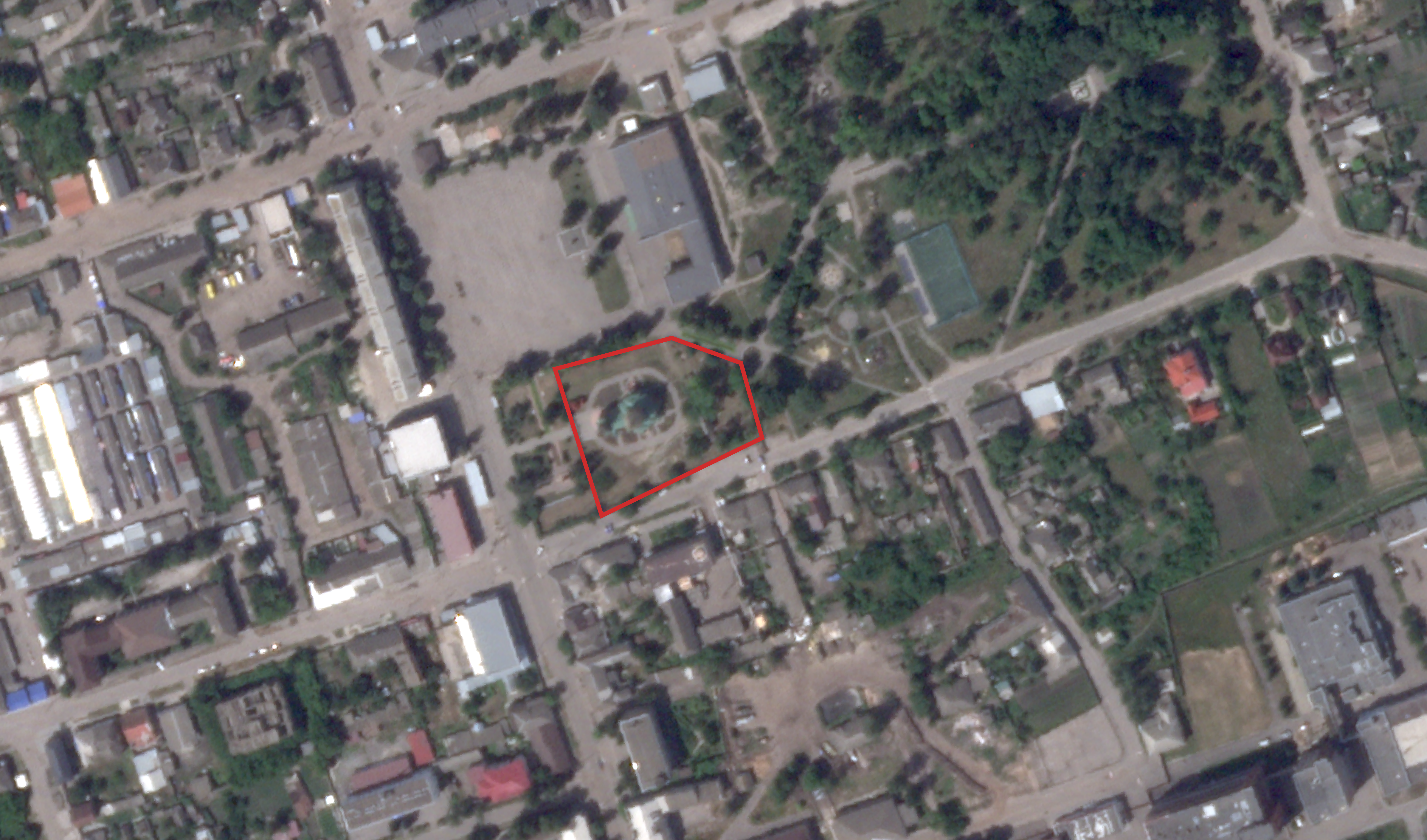
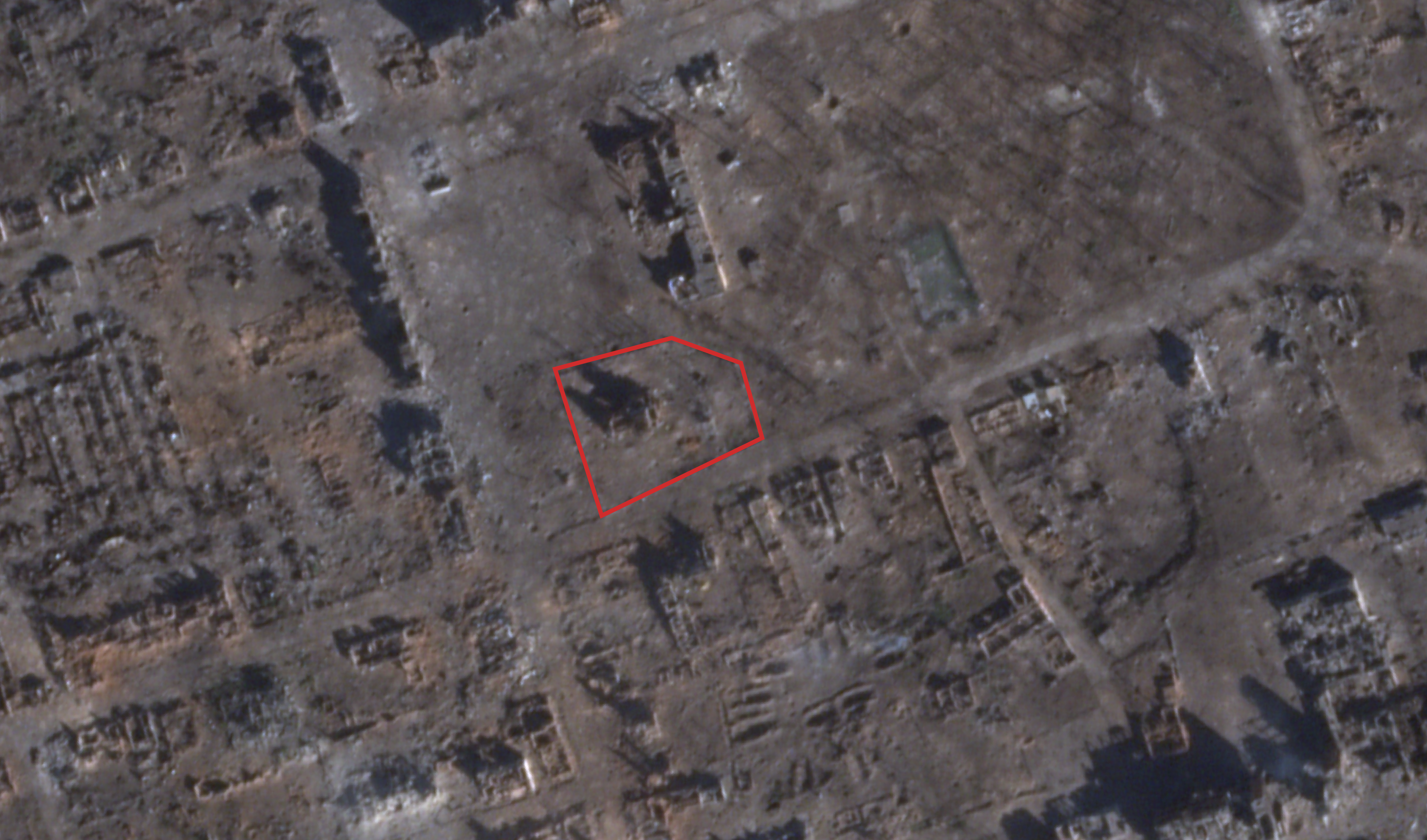
‘Wherever Ukraine Is, We Will Be There’
The fight over Vovchansk is far from over. The spokesperson for the Kharkiv regional military forces, Vitalii Sarantsev called the situation difficult with Russian troops using “the maximum range of weapons” near the city.
Russia’s MInistry of Defence did not respond to AFP’s request for comment on the situation in Vovchansk.
However, Lieutenant Denys Yaroslavsky of Ukraine’s 57th Brigade Reconnaissance Unit told AFP that people were weary.
“I hate to say it, but a lot of fighters who have been on the battlefield since the beginning of the war are now tired, want to complete their mission and move abroad. These are the soldiers who are now giving their lives for Ukraine, and they want to move to other countries,” he said.
Nelia Stryzhakova has no immediate plans for her future.
“Our city is beautiful, but no one will move to the border with Russia. We don’t know what will happen, under what conditions the war will end and how,” she said. “But wherever Ukraine is, we will be there,” she added.
Jake Godin, Logan Williams, Gyula Csák, Michael Sheldon and Eoghan Macguire contributed to this report for Bellingcat.
Boris Bachorz collected interviews and reported from Kharkiv for AFP with most interviews arranged thanks to Oleksiy Obolenskyy.
Bellingcat is a non-profit and the ability to carry out our work is dependent on the kind support of individual donors. If you would like to support our work, you can do so here. You can also subscribe to our Patreon channel here. Subscribe to our Newsletter and follow us on Twitter here and Mastodon here.
如有侵权请联系:admin#unsafe.sh